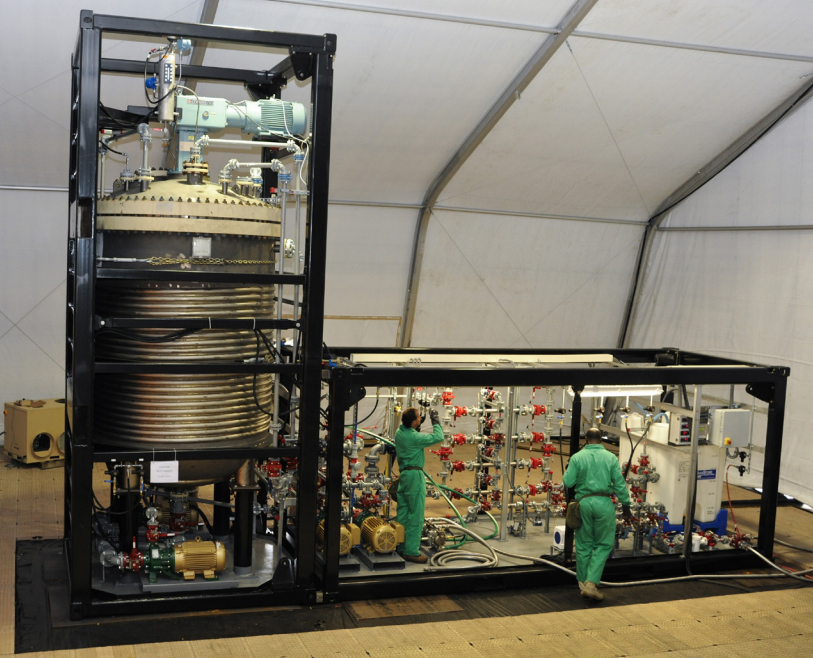You are here
submitted by Sarah Slaughter

The Field Deployable Hydrolysis System was designed, developed and fabricated by a government team to provide a transportable, high throughput neutralization system designed to convert chemical warfare materiel into compounds not usable as weapons.
defense.gov
The Field Deployable Hydrolysis System (FDHS) is a transportable, high-throughput modular demilitarization system designed to render chemical warfare materiel into compounds not usable as weapons. The system uses neutralization technology to destroy bulk chemical warfare agents and their precursors by heating and mixing with reagents, such as water, sodium hydroxide and sodium hypochlorite to facilitate chemical degradation resulting in a destruction efficiency of 99.9 percent. The neutralization process generates hazardous waste in volumes of five to 14 times the volume of chemical warfare materiel treated. This hazardous waste can then be commercially disposed of in accordance with host-nation environmental laws.
SUSCEPTIBILITY TO DISINFECTANTS: Ebolavirus is susceptible to 3% acetic acid, 1% glutaraldehyde, alcohol-based products, and dilutions (1:10-1:100 for ≥10 minutes) of 5.25% household bleach (sodium hypochlorite), and calcium hypochlorite (bleach powder) Footnote48 Footnote49 Footnote50 Footnote62 Footnote63. The WHO recommendations for cleaning up spills of blood or body fluids suggest flooding the area with a 1:10 dilutions of 5.25% household bleach for 10 minutes for surfaces that can tolerate stronger bleach solutions (e.g., cement, metal) Footnote62. For surfaces that may corrode or discolour, they recommend careful cleaning to remove visible stains followed by contact with a 1:100 dilution of 5.25% household bleach for more than 10 minutes.
PHYSICAL INACTIVATION: Ebola are moderately thermolabile and can be inactivated by heating for 30 minutes to 60 minutes at 60°C, boiling for 5 minutes, or gamma irradiation (1.2 x106 rads to 1.27 x106 rads) combined with 1% glutaraldehydeFootnote10 Footnote48 Footnote50. Ebolavirus has also been determined to be moderately sensitive to UVC radiation Footnote51.
SURVIVAL OUTSIDE HOST: Filoviruses have been reported capable to survive for weeks in blood and can also survive on contaminated surfaces, particularly at low temperatures (4°C) Footnote52 Footnote61. One study could not recover any Ebolavirus from experimentally contaminated surfaces (plastic, metal or glass) at room temperature Footnote61. In another study, Ebolavirus dried onto glass, polymeric silicone rubber, or painted aluminum alloy is able to survive in the dark for several hours under ambient conditions (between 20 and 250C and 30–40% relative humidity) (amount of virus reduced to 37% after 15.4 hours), but is less stable than some other viral hemorrhagic fevers (Lassa)Footnote53. When dried in tissue culture media onto glass and stored at 4 °C, Zaire ebolavirus survived for over 50 days Footnote61. This information is based on experimental findings only and not based on observations in nature. This information is intended to be used to support local risk assessments in a laboratory setting.
A study on transmission of ebolavirus from fomites in an isolation ward concludes that the risk of transmission is low when recommended infection control guidelines for viral hemorrhagic fevers are followed Footnote64. Infection control protocols included decontamination of floors with 0.5% bleach daily and decontamination of visibly contaminated surfaces with 0.05% bleach as necessary.
CLICK HERE - FACT SHEET - Field Deployable Hydrolysis System (FDHS) - (1 page .PDF file)
CLICK HERE - VIDEO - FDHS Process Animation - U.S. Department of Defense
CLICK HERE - ECBC transitions new WMD elimination technology to JPEO-CBD
CLICK HERE - Wikipedia - Field Deployable Hydrolysis System
CLICK HERE - Ebolavirus - Pathogen Safety Data Sheet



Recent Comments